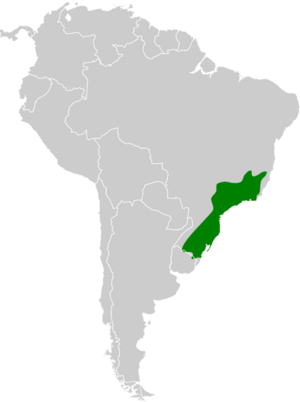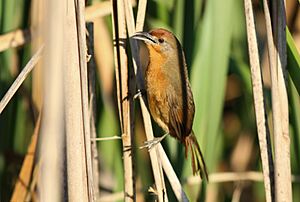Orange-breasted thornbird facts for kids
Quick facts for kids Orange-breasted thornbird |
|
|---|---|
 |
|
| At Reserva Guainumbi, São Luís do Paraitinga, São Paulo State, Brazil | |
| Conservation status | |
| Scientific classification | |
| Genus: |
Phacellodomus
|
| Species: |
ferrugineigula
|
 |
|
| Synonyms | |
|
P. erythrophthalmus ferrugineigula |
|
The orange-breasted thornbird is a cool bird from the ovenbird family. Its scientific name is Phacellodomus ferrugineigula. You can find this bird mainly in Brazil and Uruguay, and possibly even in Argentina.
Contents
About the Orange-breasted Thornbird
How Scientists Classify This Bird
The orange-breasted thornbird is a unique species. For a long time, scientists thought it was just a type of orange-eyed thornbird. Both birds were even called "red-eyed thornbirds" for a while!
But scientists noticed some big differences. The orange-breasted thornbird has different eye and feather colors. It also sings a different song. These birds live in the same areas in São Paulo state but do not mix. This showed scientists they were two separate species.
To avoid confusion, the names were changed. Now we have the "orange-eyed" and "orange-breasted" thornbirds.
Years ago, some scientists thought these birds belonged to a different group called Drioctistes. But newer studies, using modern DNA tests, confirmed that both species belong in the Phacellodomus group.
What the Orange-breasted Thornbird Looks Like
The orange-breasted thornbird is about 17 to 18 centimeters (about 7 inches) long. It weighs around 24 to 25 grams (less than an ounce). Both male and female birds look the same.
This bird has a rufous-brown stripe above its eye. Its face is brownish, with a darker stripe behind the eye. The top of its head is a bright rufous color.
Its back and rump are dark brownish-olive. The feathers covering its tail are a chestnut-brownish-olive. Its wings are mostly warm brown, brighter near the body and duller at the tips. The tail is brownish-olive with rufous outer feathers.
The throat and chest of the bird are orange-rufous. Its belly is whitish, and its sides are warm brown with some rufous. The bird has red eyes. Its upper beak is black, and its lower beak is gray. Its legs and feet are greenish-gray to gray.
Where the Orange-breasted Thornbird Lives
The orange-breasted thornbird lives in southeastern Brazil. You can find it from Minas Gerais and Espírito Santo down to Rio Grande do Sul.
In 2001, this bird was found in Uruguay for the first time. Scientists even found a nest there, showing they were breeding. Since then, they have been seen regularly in Uruguay. There have also been sightings in Argentina, but these have not been fully confirmed yet.
Orange-breasted Thornbird Habitat
This bird likes to live in thick bushes near freshwater marshes or rivers. It also lives in gallery forest (forests along rivers), swampy woodlands, and dense secondary forest (forests that have regrown after being cut down).
You can usually find them from sea level up to about 750 meters (about 2,460 feet) high. But in Minas Gerais, they can be found up to 1,250 meters (about 4,100 feet). In Espírito Santo, they can reach 1,100 meters (about 3,600 feet).
Orange-breasted Thornbird Behavior
Movement
The orange-breasted thornbird stays in the same area all year long. It does not migrate.
Feeding Habits
Scientists believe the orange-breasted thornbird mainly eats arthropods, like insects and spiders. It usually looks for food alone or in pairs. It picks prey off plants in the thick undergrowth of the forest.
Reproduction and Life Cycle
The breeding season for the orange-breasted thornbird includes December to February. These birds are thought to be monogamous, meaning a pair stays together.
They build a special nest that looks different from other thornbird nests. They weave leaves and grass stems into a tight, round structure. It is about 40 centimeters (about 16 inches) wide and tall. The nest has a tube-like entrance.
The bird usually hangs its nest from the tip of a branch. It is often about 1.6 meters (about 5 feet) above the ground or water. They lay at least two eggs. Scientists do not yet know how long the eggs take to hatch or when the young birds leave the nest.
Vocalization
The orange-breasted thornbird's song is a series of loud, clear notes. It often starts with one or two softer notes, like "ku, keeé-keeé-keeé-keeé-keeé-kuh". A pair of birds will often sing this song together.
Status of the Orange-breasted Thornbird
The IUCN (International Union for Conservation of Nature) has listed the orange-breasted thornbird as a species of "Least Concern." This means it is not currently in danger of disappearing.
The bird lives across a large area. While its exact population size is unknown, scientists believe the number of birds is stable. There are no immediate threats to this species. It is considered uncommon, but it lives in several protected areas.



